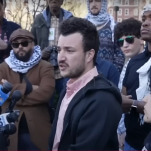'A Carnival of Desire': Dina Litovsky's Gorgeous, Strange Photos of the Meatpacking District
EntertainmentNew York’s Meatpacking District is, these days, a glittering and slightly surreal place. Once a gritty neighborhood known for its sex clubs, gay nightlife and drag queens (and before that, literal animal carcasses), it’s transformed in recent years into a playground for the hyper-rich and the velvet-roped clubs they seem to prefer. It has obsessed photographer Dina Litovsky for three summers, who sees it as a stage where sexual politics, social mores, and mating rituals play out in unusually public ways. She spent long, late hours in the neighborhood, working to capture fleeting, spontaneous interactions on the streets.
Litovsky has shot for a host of publications; she’s been published everywhere from the New York Times to National Geographic to GQ. She recently spoke to Jezebel about her experience capturing the Meatpacking’s bizarre carnival. Her full photo series is viewable here. You can also see her work on Instagram.
JEZEBEL: The detail you captured here is incredible—women supporting themselves against a wall, changing from flip flops into heels, these fleeting gaping looks of men as women walk past them, a stampede of bachelorettes crossing a lonely street as a guy in a suit does a double-take. It must have taken forever, and it must’ve required being inconspicuous. Tell me about the experience of photographing the scene—how many nights did you spend there? How did you dress? Did you stand against a wall?
Dina Litovsky: I’ve spent more evenings in the Meatpacking than I ever thought possible. Some of the first images came effortlessly, men gaping at women, tripping heels on the cobblestone. But soon after I realized that I need to look for more complex, surprising moments that required a lot of patience and walking around. Because I wasn’t using flash for this project, I could only photograph in specific places that were lit by street lamps, lights from passing cars or vendor carts. If I saw something interesting happening at a location, I’d hang around to wait for a photo opportunity. Many times I had to pretend to be on my phone so the people who interested me wouldn’t realize I’m intending to photograph them. I would dress as comfortably and inconspicuously as I could, black jeans and t-shirt and flip-flops of course.
You talk in your statement and in an interview with Time’s photo blog about the very blunt, visible sexual politics and courtship rituals on display. Men catcall, whistle at and sometimes physically grab women, and women accept the attention, sometimes enthusiastically. Are people pairing off? Is romance, or at least sex, in the air, or is it more about seeing and being seen?
I don’t recall people pairing off right from the street. Numbers could have been exchanged but once I would get the photo I wanted I’d leave the scene. At the start of the night, the attitude was more about being seen, but as the evening progressed interactions became looser and visibly sexual.
You told Time that you were occasionally grabbed or propositioned. How did you respond? Were you disrupting the social order by being a young woman in that scene and yet somehow not there to hook up?
Almost every night that I was shooting I had some kind of incident where I was catcalled, propositioned or even followed. In the beginning I was a bit naïve and would try to explain that I’m a photographer and not interested. Once I gave out my business card when asked, and the guy continued texting me for a long time after, even finding me on social media. After that experience I stopped giving out any personal information, and when I would see someone coming toward me I would just cross the street to avoid any interaction. Still, I’ve had some unpleasant experiences of being grabbed and insulted after refusing to “smile.” Many guys seemed incredulous that a woman walking alone at night was not happy about their advances after 2 a.m. If I was shooting this late, I always tried to find a spot near a patrol car, that was always the safest place where I could photograph undisturbed.
How did you feel about your subjects and what you were witnessing? I love these series in part because it feels sort of cool, analytical, ironically curious and yet non-judgmental. It doesn’t feel like you exactly like these people but you also weren’t horrified by all this excessive peacocking.
-

-

-

-

-

-

-

-

-

-

-

-

-

-

-

-

-

-

-

-

-

-

-

-

-

-

-

-

-

-

-

-

-

-

-

-

-

-

-

-








































